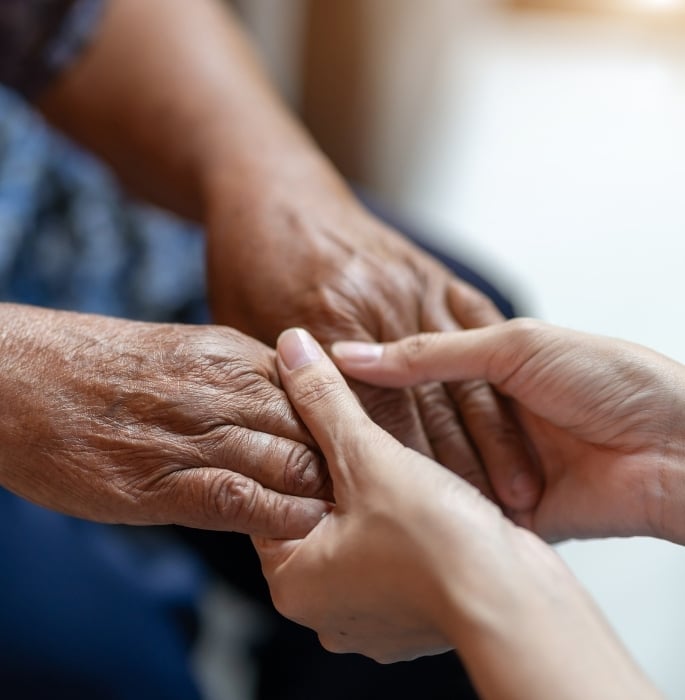“We need to hear patient voices more and act on any disparity.”
People with learning disabilities face greater challenges accessing healthcare in the UK, and these obstacles are even more pronounced for ethnic minorities.
This community already “die 19.5 years younger than the general population.”
When ethnicity is considered, new findings reveal that South Asians are dying 20 years earlier than their white counterparts.
This gap reflects the longstanding failures in healthcare that expose vulnerable groups to racism and ableism, serving as a painful reminder that the system lacks supportive and inclusive care.
Established in 2021, the NHS Race & Health Observatory has played a pivotal role in tackling inequalities by driving policy changes and offering practical solutions.
An independent investigation by this organisation uses lived experience to highlight just how deeply this crisis runs.
Language barriers, religious insensitivity, and inaccessible services have created a neglectful and disempowering system for South Asian communities.
Tackling this marginalisation is necessary to create fairer healthcare for all.
The Inequality Uncovered
 To address this inequality, the report identified a range of prejudices embedded within healthcare.
To address this inequality, the report identified a range of prejudices embedded within healthcare.
It found that laws weren’t being followed sufficiently, important data weren’t being recorded, and patients were often left without the care they needed.
These deficiencies are mirrored in the life expectancy crisis for ethnic minorities, with the “average age of death… [at] 34 years, just over half the expectancy of white counterparts, at 62.”
Such shocking statistics frustrate Siraaj Nadat, one of the main people working on this report.
He has lived experience of the unending challenges facing this group as a disabled British Asian man.
The necessity to make healthcare more accommodating and equal is at the forefront of his work, especially after hearing horrific experiences of discrimination.
A 44-year-old Pakistani woman recalled her shock and disappointment at a doctor’s hasty first impression of her.
She is a carer for her daughter, who has learning disabilities, and described repeated instances of being unfairly judged because of her race.
The doctor made stereotypical assumptions about her physical appearance as an Asian woman.
“I don’t know what age we’re stuck in, but people see me and immediately make judgments. The doctor thinks I can’t speak English.”
Facing double discrimination as an ethnic minority and a carer, the woman endured the same humiliation and insensitivity on two separate occasions.
This display of ignorance is widely familiar to many carers, with doctors oversimplifying key medical advice or speaking patronisingly slowly.
Nadat urges professionals and the public alike “to see the person first, not the disability or race,” for a more humanising approach to patient care.
Recognising them as equals is essential to creating a fairer environment within healthcare.
However, this desire is challenged by the frequency of double discrimination within the system.
This occurs when a person is discriminated against because of their race and disability, making them even more vulnerable to poorer care.
Both situations directly impact the livelihood of the patient.
Without providing all details of medical guidance, important symptoms or changes in patients can be missed, leading to serious consequences.
If patients and carers struggle to communicate in English, doctors are legally obliged to make reasonable adjustments.
These adjustments include the use of interpreters or offering longer appointment times.
Yet the report found that such adjustments were implemented much less often, or to an insufficient standard.
Healthcare has become increasingly exclusive, making these vulnerable communities more invisible and helpless.
Tailoring healthcare to the specific needs of each individual is the only way to ensure equal treatment and tackle prejudices.
Behind the statistics and stories lies a deeper emotional toll felt within many homes.
The Human Impact
 For many families, the possibility of a loved one dying at 34 should be unthinkable, but it remains a harsh reality.
For many families, the possibility of a loved one dying at 34 should be unthinkable, but it remains a harsh reality.
Each death reflects the struggles and challenges endured because of discrimination, inequality, and a lack of systematic change within healthcare.
The following responses illustrate the emotional impact of the report’s findings.
One 20-year-old British Asian woman shared how deeply hurt she was to learn about the vast difference in life expectancies between Asian and white people.
Her older brothers have learning disabilities, so she felt unsettled when commenting on the report.
“This is very disappointing. It really highlights the health discrepancies in the UK and showcases the real-life impact of the racial gap.”
The idea that people like her brothers were less likely to reach their forties was deeply worrying.
However, she wasn’t too shocked by the health gap.
Instead, she recalled her brother’s friend, who also had learning disabilities. He did not even live to thirty.
This revelation felt surreal, yet it was another reminder of the injustices prevalent within healthcare for these communities.
A 20-year-old white British woman also conveyed her distress and confusion to DESIblitz when informed of the differences in life expectancies between Asian and white people.
“34 is too young! It is unimaginable that many will be told they are less likely to live past that age.”
Further comments summed up her increased frustrations towards the severity of these inequalities:
“We need to understand how and why the health system has deteriorated to such an extent, and more importantly, how changes can be effectively implemented in resolving this racial inequality. I am ashamed to learn of this.”
Her reaction intensified when she learned that more ethnic minority groups were permitted to be resuscitated than their white counterparts.
Despite this willingness to live, the life expectancy rates within this group remain low.
These experiences reflect a system that does not value all lives equally.
It seems as though family members and friends are the main form of support for those with learning disabilities, rather than the healthcare system itself.
These narratives reveal the human impact of a crisis that data alone cannot fully convey.
But to truly grasp the scale of this issue, it’s important to understand the cracks within the data.
Causes & Gaps in Healthcare
 The NHS report suggests that ethnic minorities with learning disabilities “experience inequalities based on both factors… a ‘double discrimination’.”
The NHS report suggests that ethnic minorities with learning disabilities “experience inequalities based on both factors… a ‘double discrimination’.”
As members of two marginalised groups, access to both general and specialist healthcare becomes far more difficult.
This exclusivity places these communities at greater risk.
Missed diagnoses, lower quality of care, and mistrust are some of the key impacts of this discrimination.
When doctors fail to respond seriously to medical concerns, a lack of trust between patient and doctor begins to form.
The patient is then less likely to visit their GP as often, meaning symptoms may be missed.
More serious illnesses may only be discovered at later stages, with fewer treatment options available as a result.
These real-life consequences directly contradict the 2010 Equality Act.
The act states that race and disability are both ‘protected characteristics’.
It is illegal to discriminate against someone based on these features, whether in professional settings, education, or healthcare.
As part of this act, reasonable adjustments were introduced within various organisations.
These measures aim to ensure disabled people are accommodated, rather than disrespected.
Interpreters, longer appointment times, and more accessible information (for example, visual aids) are among the main adjustments provided within healthcare systems.
For instance, interpreters help prevent miscommunication caused by language barriers, allowing patients to better understand crucial information.
An interpreter holds great significance for the patient in this situation.
Here, the patient has agency and can actively participate in conversations about their health, allowing them to make informed choices between different treatments.
Through reasonable adjustments, patients are given a platform to voice their opinions.
In reality, the report found that many felt misunderstood or discriminated against, often “being denied access to treatment that was deemed to be beneficial.”
They were left voiceless and powerless without an interpreter.
This lack of care and inclusivity amounts to a form of “systematic” racism.
After interviewing patients from various ethnic communities, the report found that many experienced subtle racism rather than overt discrimination.
This hidden bias shows just how accepted it has become in daily life.
The invisibility of this racism is reflected in the underreporting of deaths among ethnic minorities with learning disabilities.
Without sufficient data, the problem is harder to understand, meaning fewer deaths are prevented.
No real change can be implemented without a true understanding of the issue.
Breaking Down the Data
 The Learning Disabilities Mortality Review (LeDeR) reveals how the disparities uncovered by the NHS have deadly consequences for many.
The Learning Disabilities Mortality Review (LeDeR) reveals how the disparities uncovered by the NHS have deadly consequences for many.
LeDeR recently released findings analysing the health and care people received before their deaths.
It assessed whether effective and satisfactory healthcare was provided and how this affected the end of a person’s life.
The report also highlighted ways to improve services to ensure the best quality of care for this group.
In the latest review, LeDeR studied the deaths of 8,773 adults with learning disabilities and autism between January 2021 and December 2023.
This is the first time it has dedicated a chapter to the deaths of individuals from ethnic minority communities, a necessary step towards addressing these long-overlooked issues.
The findings are deeply concerning for South Asians.
LeDeR categorised unnecessary deaths into three groups:
- Preventable – avoided through measures like vaccinations.
- Treatable – avoided through efficient healthcare.
- Avoidable – preventable and/or treatable.
What stands out is that diseases of the nervous system were the most frequent cause of death for “Asian or Asian British” individuals.
As a result, this community is more vulnerable to conditions such as Alzheimer’s, Parkinson’s, cerebral palsy, and epilepsy.
These illnesses can affect everything from memory to movement, showing just how serious the risks are.
It also suggests that some of these illnesses are not being prevented as effectively as they could be.
For instance, doctors could monitor the health and diet of South Asians more closely to ensure nutritional balance, as this may help reduce the likelihood of Alzheimer’s.
Despite these disparities, South Asians remain vastly underrepresented in the data.
This reflects a failure of care rooted in both neglect and inadequate research.
In 2023, LeDeR was notified of only 2.9% of deaths from the “Asian or Asian British” community, compared to a much larger 36.4% from the “White” community.
This underrepresentation means that South Asian struggles remain overlooked and continue to worsen.
Without accurate reporting, there is little understanding of how many people are dying prematurely, or why.
Without this knowledge, conversations about improving healthcare for these communities cannot progress, allowing inequalities to persist.
A lack of data leads to less reliable findings, but more importantly, it has life-or-death consequences.
If healthcare providers fail to recognise how age, ethnicity, and disability intersect in people’s lives, services will remain inaccessible.
Without awareness, there can be no progress.
That is why it is now a legal requirement for all ethnicities to be recorded on death certificates, helping increase visibility for those previously overlooked.
LeDeR stated that the most “notable difference in the age of death” for people from ethnic minority groups was among those identified as “Asian or Asian British.”
However, the most shocking revelation is that only 11.6% of South Asians lived past 65, compared to over 44% of white people reaching that age.
This stark difference emphasises the urgency for targeted health interventions.
Behind these statistics are real people whose lives have been deeply affected, making it clear that serious change must be a priority.
Calls for Change
 Both reports highlight the urgency for change within the healthcare system for South Asians.
Both reports highlight the urgency for change within the healthcare system for South Asians.
Neglect of care and understanding has fatal consequences for too many families.
Jabeer Butt, Chief Executive of the Race Equality Foundation, reiterated the importance of catering to patients’ needs and circumstances, while also providing them with a platform to share their concerns and experiences of discrimination.
He stated: “Healthcare providers should do more to actually implement existing policies relating to people with a learning disability.
“We need to hear patient voices more and act on any disparity.”
By giving them a voice, Butt hopes to empower them in an environment that currently feels suffocating.
Other recommendations from the report include further research into health differences across ethnicities.
This commitment to helping medical staff understand each group’s health risks can raise awareness of certain symptoms and help prevent illness.
Encouraging awareness campaigns also highlights the importance of inclusivity and ensures all voices are heard.
Such campaigns can help reach members of ethnic communities, alerting individuals to services such as annual health checks to ensure their well-being is consistently monitored.
Making medical services more accessible doesn’t just benefit one group. It helps create a system that works for everyone.
However, deeper systemic change is needed to make inclusion more than just a promise.
Will Healthcare ever be Truly Inclusive?
 Right now, the healthcare system continues to fail ethnic minorities with learning disabilities.
Right now, the healthcare system continues to fail ethnic minorities with learning disabilities.
A life expectancy of 34 is not just a statistic but a crisis born from prejudice and inaction.
Despite legal requirements, reasonable adjustments are often treated as optional, costing thousands of innocent lives.
Unless change is implemented, double discrimination, limited data, and persistent bias will continue to fuel this deadly crisis.
Protecting and respecting all lives is vital, as no one’s life should ever be compromised.
With collective awareness and action, equality can become a reality rather than a distant goal.






























































